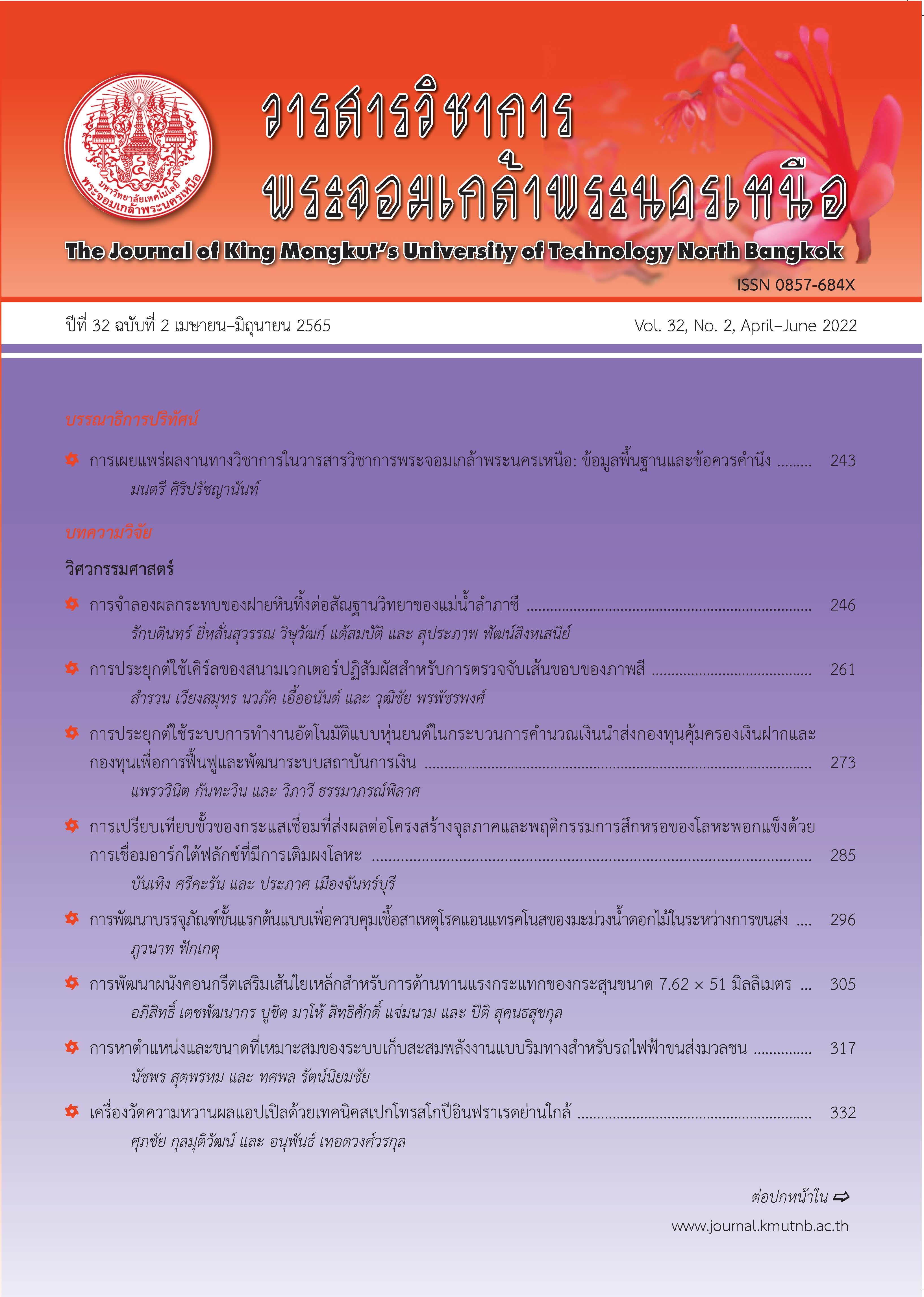การเปลี่ยนแปลงคุณภาพของไข่เค็มพอกดินที่ทดแทนเกลือโซเดียมคลอไรด์ด้วยเกลือโพแทสเซียมคลอไรด์ในระหว่างการเก็บรักษา
Main Article Content
บทคัดย่อ
การบริโภคเกลือโซเดียมคลอไรด์ในปริมาณสูงมีความสัมพันธ์ต่อโรคต่าง ๆ เช่น โรคความดันโลหิตสูงและโรคที่เกี่ยวข้องกับหลอดเลือดหัวใจ สำหรับอาหารหมักดอง โดยเฉพาะอย่างยิ่งผลิตภัณฑ์ไข่เค็มนั้น ถือได้ว่าเป็นแหล่งของการได้รับโซเดียมในปริมาณสูงจากการบริโภค ดังนั้น การลดปริมาณเกลือในไข่เค็มลงจึงส่งผลดีต่อสุขภาพของผู้บริโภคได้ งานวิจัยนี้ ศึกษาการเปลี่ยนแปลงคุณภาพของไข่เค็มพอกดินที่ทดแทนเกลือโซเดียมคลอไรด์ (NaCl) ด้วยเกลือโพแทสเซียมคลอไรด์ (KCl) ที่ระดับร้อยละ 0, 25, 50, 75 และ 100 ในระหว่างการเก็บรักษา 4 สัปดาห์ จากผลการทดลอง พบว่า ค่าความสว่าง (L*) และค่าความเป็นสีเหลือง (b*) ของไข่แดงมีค่าเพิ่มขึ้นเมื่อปริมาณเกลือ KCl เพิ่มมากขึ้น นอกจากนี้ การใช้ KCl ในปริมาณมากขึ้นยังส่งผลให้ร้อยละสัดส่วนไข่แดงที่แข็งมีค่าลดลง โดยไข่แดงไม่เปลี่ยนเป็นเจลยืดหยุ่นอย่างสมบูรณ์ตลอดระยะเวลาการเก็บรักษาซึ่งส่งผลให้ความแข็งของไข่แดงสุกมีค่าลดลง อย่างไรก็ตาม ความแข็งของไข่ขาวเค็มสุกมีค่าเพิ่มขึ้นเมื่อปริมาณเกลือ KCl เพิ่มมากขึ้น นอกจากนี้ยังพบว่า ไข่เค็มพอกดินที่ทดแทนเกลือโซเดียมคลอไรด์ด้วยเกลือโพแทสเซียมคลอไรด์ในระดับร้อยละ 50 ที่ระยะเวลาการพอก 2 สัปดาห์ มีคะแนนการยอมรับทางประสาทสัมผัสในด้านสี กลิ่น รสเค็ม รสชาติโดยรวม และความชอบโดยรวมสูงและไม่แตกต่างจากสูตรควบคุม (0%KCl) (p>0.05) โดยมีปริมาณ Na+ ที่วิเคราะห์ด้วยวิธี Inductively Coupled Plasma-Mass Spectrometry (ICP-MS) เท่ากับ 711.5 มิลลิกรัม/100 กรัม ซึ่งลดลง 2.3 เท่าเมื่อเทียบกับสูตรควบคุมหรือคิดเป็นสัดส่วน 1 ใน 3 ของปริมาณที่แนะนำให้บริโภคต่อวัน และมีปริมาณ K+ เท่ากับ 891.80 มิลลิกรัม/100 กรัม เพิ่มขึ้น 6.7 เท่าเมื่อเทียบกับสูตรควบคุม
Article Details

อนุญาตภายใต้เงื่อนไข Creative Commons Attribution-NonCommercial-NoDerivatives 4.0 International License.
บทความที่ลงตีพิมพ์เป็นข้อคิดเห็นของผู้เขียนเท่านั้น
ผู้เขียนจะต้องเป็นผู้รับผิดชอบต่อผลทางกฎหมายใดๆ ที่อาจเกิดขึ้นจากบทความนั้น
เอกสารอ้างอิง
N. J. Aburto, A. Ziolkovska, L. Hooper, P. Elliott, F. P. C. Cephalon, and J. J. Meerpohl, “Effect of lower sodium intake on health: systematic review and meta-analyses,” BMJ Journals, vol. 346, pp. 1–20, 2013.
World Health Organization. (2020, June). Guideline: Sodium Intake for Adults and Children. [Online]. Available: http://www.who. int/nutrition/publications/guidelines/sodium_ intake_printversion.pdf
K. Cepanec, S. Vugrinec, T. Cvetkovi, and J. Ranilovi, “Potassium chloride-based salt substitutes: A critical review with a focus on the patent literature,” Comprehensive Reviews in Food Science and Food Safety, vol. 16, pp. 881 – 894, 2017.
C. Asril. (20 June 2020). How much salted egg yolk is too much?. [Online]. Available: https:// www.todayonline.com/lifestyle/food/howmuch- salted-egg-yolk-too-much
B. Thumthanarak and T. Teerapornkittikul, “Quality of reduced sodium steamed mackerel during chilled storage,” The Journal of Applied Science, vol. 17, pp. 125–139, 2018 (in Thai).
R. E. Stanley, C. G. Bower, and G. A. Sullivan, “Influence of sodium chloride reduction and replacement with potassiumchloride based salts on the sensory and physico-chemical characteristics of pork sausage patties,” Meat Science, vol. 133, pp. 36–42, 2017.
S. P. Chi and K. H. Tseng, “Physicochemical properties of salted pickled yolk from duck and chicken eggs,” Journal of Food Science, vol. 33, pp.507–513, 1998.
A. V. A. Resurreccion. Consumer Sensory Testing for Product Development, Gaithersburg, Md.: Aspen Publishers, 1998.
C. W. Lin. “The storage of egg,” in The chemistry and utility of egg, H.S. Yuan (Ed.). Publishing Co., Taipei, Taiwan, 1983, pp.98–121.
H. Sugino, T. Nitoda, and L. R. Juneja, “General chemical composition of hen eggs,” in Hen Eggs: Their Basic and Applied science, T. Yamamoto, L.R. Juneja, H. Hatta and M. Kim, (Eds.). CRC Press., Boca Raton, Florida, USA, 1996, pp. 13–24.
L. J. Harrison and F. E. Cunningham, “Influence of salt on properties of liquid yolk and functionality in mayonnaise,” Poultry Science, vol. 65, pp. 915– 921, 1986.
A. Laoharatanahiran, “Novel approach in ameliorating saltiness of salted yolk cured using separated yolk brining process,” M.S. thesis, Department of Food Engineering, King Mongkut’s University of Technology Thonbury, Bangkok, Thailand, 2005.
A. C. Alting. (2020, June). Cold gelation of globular proteins. [Online]. Available: https:// edepot.wur.nl/43368.
T. M. Johnson and M. E. Zabik. “Gelation properties of albumen proteins, singly and in combination,” Poultry Science, vol. 60, pp. 2071–2083, 1981.
P. W. Gossett, S. S. H. Rizvi, and R. C. Baker, “Quantitative analysis of gelation in egg protein system,” Food Technology, vol. 38 no. 5, pp. 67–96, 1984.
F. S. Shenstone, “The gross composition, chemistry and physico-chemical basis of organization of the yolk and white,” in Egg Quality: A study of the Hen’s Egg, T.C. Carter (Ed.). Oliver & Boyd, Edinburgh, United Kingdom, 1968, pp. 26–58.
A. Guerrero, J. A. Carmona, I. Martínez, F. Cordobés, and P. Partal, “Effect of pH and added electrolyte on the thermal-induced transitions of egg yolk,” Rheologica Acta, vol. 43, pp. 539–549, 2004.
T. Ichikawa and M. Shimomura, “Effects of sodium shloride and other salts on the properties of diluted egg white sols and gels,” Food Science and Technology Research, vol. 13, no. 2, pp. 173– 177, 2007.
M. C. E. Belz, L. A. M. Ryan, and E. K. Arendt, “The impact of salt reduction in bread: A review,” Critical Reviews in Food Science and Nutrition, vol. 52, pp. 514–524, 2012.
J. D. Lee. “Group I – the alkali metal,” in Concise Inorganic Chemistry. 4th ed. Singapore : Fong & Sons Printer Pte. Ltd., 1991, ch. 9, pp. 275–312.
C. N. Horita, V. C. Messias, M. A. Morgano, F. M. Hayakawa, and M. A. R. Pollonio, “Textural, microstructural and sensory properties of reduced sodium frankfurter sausages containing mechanically deboned poultry meat and blends of chloride salts,” Food Research International, vol. 66, pp. 29–35. 2014.
B. D. Tobin, M. G. O'Sullivan, R. M. Hamill, and J. P. Kerry, “Effect of varying salt and fat levels on the sensory and physiochemical quality of frankfurters,” Meat Science, vol. 92, pp. 145–152, 2012.
S. P. Ponce, A. E. Jennings, N. E. Madias, and J. T. Harrington, “Drug-induced hyperkalemia,” Medicine (Baltimore), vol. 64, no.6, pp. 357–70, 1985.
T. Yip, W. Wan, P. C. Hui, S. L. Lui, and W. K. Lo, “Severe hyperkalemia in a peritoneal dialysis patient after consumption of salt substitute,” Peritoneal Dialysis International, vol. 32, no. 2, pp. 206–208, 2012.

